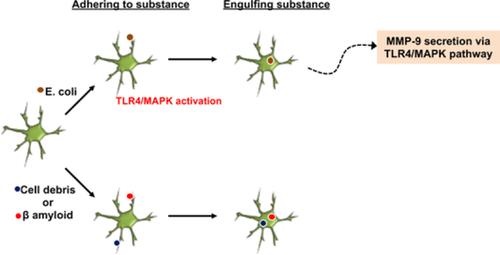Our official English website, www.x-mol.net, welcomes your feedback! (Note: you will need to create a separate account there.)
Microglial responses after phagocytosis: Escherichia coli bioparticles, but not cell debris or amyloid beta, induce matrix metalloproteinase-9 secretion in cultured rat primary microglial cells.
Glia ( IF 6.2 ) Pub Date : 2020-02-14 , DOI: 10.1002/glia.23791 Gen Hamanaka 1, 2 , Tomoya Kubo 1, 2 , Ryo Ohtomo 1, 2 , Hajime Takase 1, 2 , Estefania Reyes-Bricio 1, 2 , Shuntaro Oribe 3 , Noriko Osumi 3 , Josephine Lok 1, 2, 4 , Eng H Lo 1, 2 , Ken Arai 1, 2
Glia ( IF 6.2 ) Pub Date : 2020-02-14 , DOI: 10.1002/glia.23791 Gen Hamanaka 1, 2 , Tomoya Kubo 1, 2 , Ryo Ohtomo 1, 2 , Hajime Takase 1, 2 , Estefania Reyes-Bricio 1, 2 , Shuntaro Oribe 3 , Noriko Osumi 3 , Josephine Lok 1, 2, 4 , Eng H Lo 1, 2 , Ken Arai 1, 2
Affiliation

|
Upon infection or brain damage, microglia are activated to play roles in immune responses, including phagocytosis and soluble factor release. However, little is known whether the event of phagocytosis could be a trigger for releasing soluble factors from microglia. In this study, we tested if microglia secrete a neurovascular mediator matrix metalloproteinase-9 (MMP-9) after phagocytosis in vitro. Primary microglial cultures were prepared from neonatal rat brains. Cultured microglia phagocytosed Escherichia coli bioparticles within 2 hr after incubation and started to secrete MMP-9 at around 12 hr after the phagocytosis. A TLR4 inhibitor TAK242 suppressed the E. coli-bioparticle-induced MMP-9 secretion. However, TAK242 did not change the engulfment of E. coli bioparticles in microglial cultures. Because lipopolysaccharides (LPS), the major component of the outer membrane of E. coli, also induced MMP-9 secretion in a dose-response manner and because the response was inhibited by TAK242 treatment, we assumed that the LPS-TLR4 pathway, which was activated by adhering to the substance, but not through the engulfing process of phagocytosis, would play a role in releasing MMP-9 from microglia after E. coli bioparticle treatment. To support the finding that the engulfing step would not be a critical trigger for MMP-9 secretion after the event of phagocytosis in microglia, we confirmed that cell debris and amyloid beta were both captured into microglia via phagocytosis, but neither of them induced MMP-9 secretion from microglia. Taken together, these data demonstrate that microglial response in MMP-9 secretion after phagocytosis differs depending on the types of particles/substances that microglia encountered.
中文翻译:

吞噬作用后的小胶质细胞反应:大肠杆菌生物颗粒诱导培养的大鼠原代小胶质细胞中基质金属蛋白酶 9 的分泌,而不是细胞碎片或淀粉样蛋白 9。
在感染或脑损伤后,小胶质细胞被激活以在免疫反应中发挥作用,包括吞噬作用和可溶性因子释放。然而,对于吞噬作用事件是否可能是小胶质细胞释放可溶性因子的触发因素知之甚少。在这项研究中,我们测试了小胶质细胞在体外吞噬作用后是否分泌神经血管介质基质金属蛋白酶-9 (MMP-9)。从新生大鼠脑中制备原代小胶质细胞培养物。培养的小胶质细胞在孵育后 2 小时内吞噬大肠杆菌生物颗粒,并在吞噬作用后约 12 小时开始分泌 MMP-9。TLR4 抑制剂 TAK242 抑制大肠杆菌生物颗粒诱导的 MMP-9 分泌。然而,TAK242 并没有改变小胶质细胞培养物中大肠杆菌生物颗粒的吞噬。因为脂多糖(LPS),大肠杆菌外膜的主要成分也以剂量反应方式诱导 MMP-9 分泌,并且由于 TAK242 处理抑制了反应,我们假设 LPS-TLR4 途径通过粘附于物质,但不是通过吞噬作用的吞噬过程,将在大肠杆菌生物颗粒处理后从小胶质细胞中释放 MMP-9 中发挥作用。为了支持吞噬步骤不会是小胶质细胞吞噬作用后 MMP-9 分泌的关键触发这一发现,我们证实细胞碎片和淀粉样蛋白 β 都通过吞噬作用被捕获到小胶质细胞中,但它们都没有诱导 MMP- 9 小胶质细胞的分泌物。综合起来,
更新日期:2020-02-14
中文翻译:

吞噬作用后的小胶质细胞反应:大肠杆菌生物颗粒诱导培养的大鼠原代小胶质细胞中基质金属蛋白酶 9 的分泌,而不是细胞碎片或淀粉样蛋白 9。
在感染或脑损伤后,小胶质细胞被激活以在免疫反应中发挥作用,包括吞噬作用和可溶性因子释放。然而,对于吞噬作用事件是否可能是小胶质细胞释放可溶性因子的触发因素知之甚少。在这项研究中,我们测试了小胶质细胞在体外吞噬作用后是否分泌神经血管介质基质金属蛋白酶-9 (MMP-9)。从新生大鼠脑中制备原代小胶质细胞培养物。培养的小胶质细胞在孵育后 2 小时内吞噬大肠杆菌生物颗粒,并在吞噬作用后约 12 小时开始分泌 MMP-9。TLR4 抑制剂 TAK242 抑制大肠杆菌生物颗粒诱导的 MMP-9 分泌。然而,TAK242 并没有改变小胶质细胞培养物中大肠杆菌生物颗粒的吞噬。因为脂多糖(LPS),大肠杆菌外膜的主要成分也以剂量反应方式诱导 MMP-9 分泌,并且由于 TAK242 处理抑制了反应,我们假设 LPS-TLR4 途径通过粘附于物质,但不是通过吞噬作用的吞噬过程,将在大肠杆菌生物颗粒处理后从小胶质细胞中释放 MMP-9 中发挥作用。为了支持吞噬步骤不会是小胶质细胞吞噬作用后 MMP-9 分泌的关键触发这一发现,我们证实细胞碎片和淀粉样蛋白 β 都通过吞噬作用被捕获到小胶质细胞中,但它们都没有诱导 MMP- 9 小胶质细胞的分泌物。综合起来,


























 京公网安备 11010802027423号
京公网安备 11010802027423号